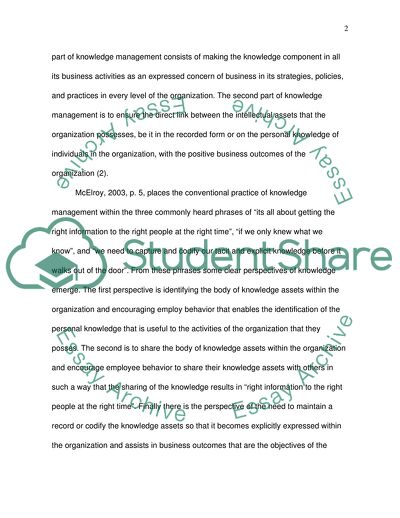
- Home
- Free Samples
- Premium Essays
- Editing Services
- Extra Tools
- Essay Writing Help
- About Us
HRD - Essay Example

- Subject: Miscellaneous
- Type: Essay
- Level: Ph.D.
- Pages: 4 (1000 words)
- Downloads: 0
- Author: pagacgarnet
Extract of sample "HRD"
It is in identifying these differences and in managing them that the key to using knowledge within the organization lies to gain a competitive edge. This activity revolves around the human asset and the in what they posses and in their behavior that makes it relevant to human resources development. (1). Barclay and Murray, 1997, define knowledge management “a business activity with two primary aspects” and go on to explain these two primary aspects. The first part of knowledge management consists of making the knowledge component in all its business activities as an expressed concern of business in its strategies, policies, and practices in every level of the organization.
The second part of knowledge management is to ensure the direct link between the intellectual assets that the organization possesses, be it in the recorded form or on the personal knowledge of individuals in the organization, with the positive business outcomes of the organization (2). McElroy, 2003, p. 5, places the conventional practice of knowledge management within the three commonly heard phrases of “its all about getting the right information to the right people at the right time”, “if we only knew what we know”, and “we need to capture and codify our tacit and explicit knowledge before it walks out of the door”.
From these phrases some clear perspectives of knowledge emerge. The first perspective is identifying the body of knowledge assets within the organization and encouraging employ behavior that enables the identification of the personal knowledge that is useful to the activities of the organization that they posses. The second is to share the body of knowledge assets within the organization and encourage employee behavior to share their knowledge assets with others in such a way that the sharing of the knowledge results in “right information to the right people at the
...Download file to see next pages Read MoreCHECK THESE SAMPLES OF HRD
Assessing HRD need is important in developing strategic HRD process
Government HRD Practice
Interview with HRD professional
Assessing HRD Need is Important in Developing Strategic HRD
Avoiding Malpractice in HRD
HRD #468 Definition Assignment
Diversity and Globalization in HRD

- TERMS & CONDITIONS
- PRIVACY POLICY
- COOKIES POLICY